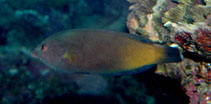| Family: |
Labridae (Wrasses), subfamily: Corinae |
| Max. size: |
31 cm TL (male/unsexed) |
| Environment: |
reef-associated; marine; depth range 1 - 25 m |
| Distribution: |
Indo-West Pacific: Mauritius to Fiji, north to the Ryukyu Islands, south to Western Australia and the Great Barrier Reef. Recently recorded from Tonga (Ref. 53797). |
| Diagnosis: |
Dorsal spines (total): 9-9; Dorsal soft rays (total): 11-13; Anal spines: 3-3; Anal soft rays: 11-13. Color of Philippine `pterophthalmus' form very dark olive-brown; scales with reddish margins; body without markings. Male form (painting) reddish brown, each scale with a vertical blue line; irregular blue lines on head and thorax; median fins with spots or stripes and colored margins. Dorsal spines pungent. Caudal fin rounded in juveniles. Juveniles with large ocelli at the ends of the dorsal and anal fins (Ref. 48636). |
| Biology: |
Adults inhabit shallow coral reefs, often in weedy areas (Ref. 9710). Feed on benthic invertebrates. Expatriate juveniles are transported by currents to subtropical zones during pelagic stages (Ref. 48636). Oviparous, distinct pairing during breeding (Ref. 205). Occasionally seen in fish markets or aquarium trade. |
| IUCN Red List Status: |
Least Concern (LC); Date assessed: 03 February 2009 Ref. (130435)
|
| Threat to humans: |
harmless |
Source and more info: www.fishbase.org. For personal, classroom, and other internal use only. Not for publication.

